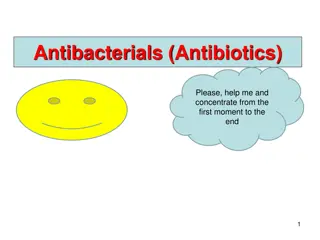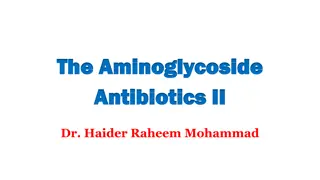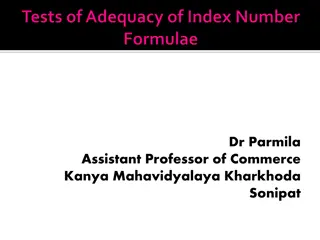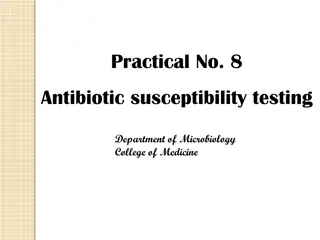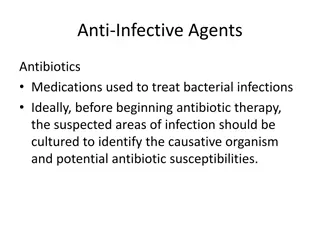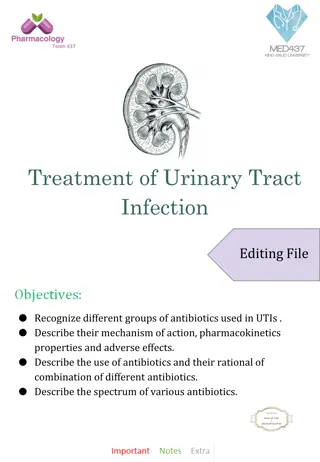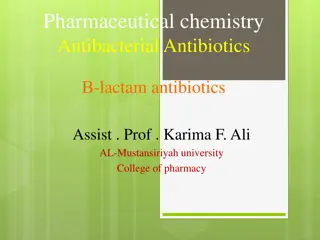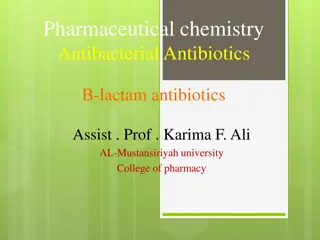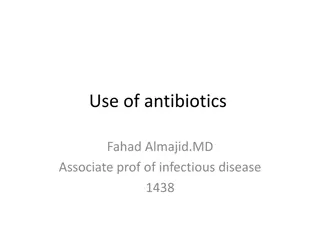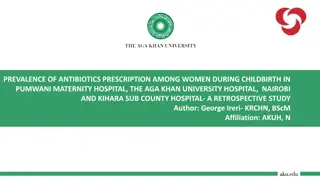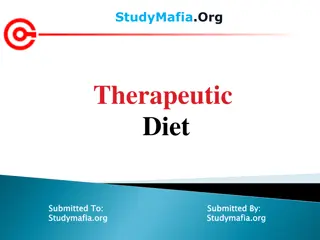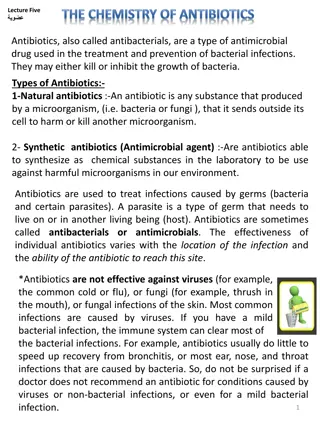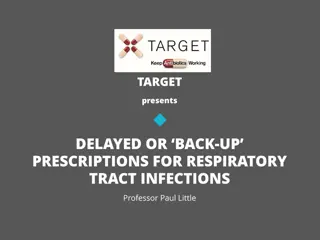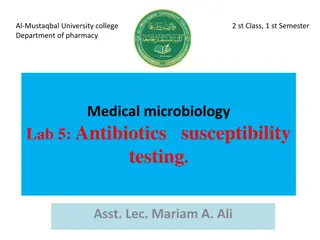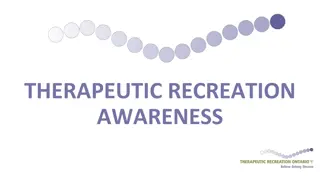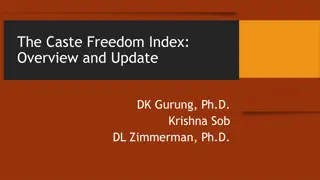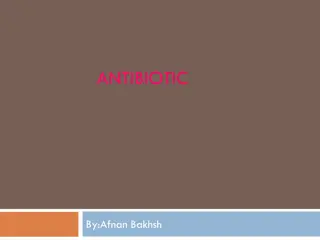Understanding Antibiotics: Mechanisms of Action and Therapeutic Index
Antibiotics play a crucial role in combating microbial infections by either killing or inhibiting bacteria. This lecture covers important topics such as the difference between bactericidal and bacteriostatic antibiotics, spectrum of activity, and the therapeutic index. It also explores the mechanisms of action of antimicrobial agents and the importance of selective toxicity in antibiotic treatment.
Download Presentation

Please find below an Image/Link to download the presentation.
The content on the website is provided AS IS for your information and personal use only. It may not be sold, licensed, or shared on other websites without obtaining consent from the author. Download presentation by click this link. If you encounter any issues during the download, it is possible that the publisher has removed the file from their server.
E N D
Presentation Transcript
microbiology microbiology LECTURE: ANTIBIOTIC *** Imp IMPORTANT. EXTRA INFORMATION. DOCTOR S NOTE
Objectives Define antibiotic, chemotherapy and selective toxicity. Describe the difference between bactericidal and bacteriostatic antibiotics Recognize the narrow and broad spectrum antibiotics Define the therapeutic index Know the mechanism of action of antimicrobial agents Recognize the various classes of antimicrobial agents (action, spectrum and side effects.) Explain the criteria for an ideal antimicrobial.
Toxicity ANTIMICROBIAL AGENTS SELECTIVE TOXICITY: The ability to kill or inhibit the growth of a microorganism without harming the host cells. Therapeutic Index: The RATIO of the dose toxic to the host to the effective therapeutic dose. Examples: Penicillin High Aminoglycosides low Polymyxin B the lowest High more safety , less toxicity CHEMOTHERAPY: Synthetic compound. Antimicrobial agents. ** ANTIBIOTICS: Natural compounds produced by microorganism which inhibit the growth of other microorganism. Like :penicillin Low less safety , more toxicity **
Mechanisms of Action of antimicrobials Activity: 1) Inhibition of cell wall synthesis. Activity of antimicrobial agent 2) alteration of cell membrane BACTERICIDAL : kills bacteria 100% will kill the bacteria BACTERIOSTATIC: prevents multiplication And help our immune system to overcome them 3) Inhibition of protein synthesis 4) Inhibition of nucleic acid synthesis Spectrum of activity The best 5) Anti-metabolite OR competitive antagonism. Broad spectrum : Gram positive & Gram negative bacteria Narrow spectrum: selected organism
Mechanisms of Action of antimicrobials 5 5) ) Anti Anti- -metabolite metabolite OR OR Competitive antagonism Competitive antagonism. . 4 4) ) Inhibition Inhibition of nucleic acid nucleic acid synthesis synthesis of 1 1) Inhibition of ) Inhibition of cell wall cell wall synthesis synthesis 2 2) ) alteration alteration of of Cell Cell membrane membrane 3) Inhibition of 3) Inhibition of protein protein synthesis synthesis Inhibit folate metabolism Aminoglycosides Beta Lactam antimicrobial agents Rifamycins Polymyxin B Trimethoprim Tetracyclines o o o o (imipenem & meropenem) o Monobactams (aztreonam) o Beta-Lactamase inhibtors Penicillins Cephalosporins Cephamycin Carbapenems Colistin Quinolones Chloramphenicol Sulfamethoxazole Macrolides Metronidazole Vancomycin ( Teicoplanin )
1) Inhibition of cell wall synthesis Beta Lactam antimicrobial agents Penicillins Benzyl Penicillin : Act mainly on gram +ve Ex: Penicillin V Benzathine Penicillin Procaine Penicillin = Penicillin G Isoxazolyl Penicillins : Act on staphylococcus aureus Ex: Cloxacillin Cephalosporins - Lactam antibiotics *Contain: Beta-lactum ring and organic acid *It can be natural or semi-synthetic 1st Generation : Ex: Cephradine Ceohalexine act on +ve 2nd Generation : Ex: Cefuroxime Cephamycin (Cefoxitin) *Bactericidal *Bind to penicillin binding protein (PBP) and interfere with trans-peptidation reaction. 3rd Generation : Expanded spectrum Ex : Ceftriaxone Ceftazidime *Toxicity: mainly 1/Hypersensitivity (allergy) 2/Anaphylaxis 3/Diarrhea Amino-Penicillins : Act on Enterobacteria Ex : Ampicillin Ex : Cefepim Ceftobiprole 4th Generation : Acylaminopenicillin : Act on Psudomonas Ex: Piperacillin Mezlocillin
1) Inhibition of cell wall synthesis Vancomycin Beta Lactam antimicrobial agents Beta-Lactamase inhibitors -Lactams with no antibacterial activity Glycopeptides Bactericidal *inhibit cell wall synthesis. Irreversibly bind to -lactamase enzyme Acts on Gram positive bacteria only ( narrowspectrum). Ex : Clavulanic acid, Sulbactam, Tazobactam Effective on staph. Penicillinases and broad spectrum -lactamases. Given by injection only. eg. amoxicillin/clavulanic acid, ticarcillin /clavulanic acid and piperacillin /tazobactam. S.epidemidis pseudomembranous colitis Used for (MRSA) Beta-Lactamase area enzymes in Bacteria act on Beta Lactam antimicrobial agents and destroy Beta-lactin ring on them , so to solve these problem we creative Beta-Lactamase inhibitors To inhibit these enzymes nephrotoxic & ototoxic. Side effects: Red man syndrome phlebitis, MRSA = methicillin resistant S.aureus systemic infections
*** Classification of Antimicrobials Mechanism of action Penicillins Glycopeptides 1) Inhibit cell wall synthesis Cephalosphoeins Beta Lactam antimicrobial agents Penicillins Cephalosporins Carbapenems Monobactams (aztreonam) Vancomycin Eg. Penicillin G +ve, some anaerobes Ampicillin Penicillin, +ve/-ve, anaerobes Pipracillin Cover Pseudomonas Eg. 1st generation = Cephalexin +ve 2nd generation = Cefuroxime +ve/-ve, Anaerobes Eg. Vancomycin Narrow spectrum Cover Only +ve Used as last option As multidrug resistance Gram +ve Can be given IV Vancomycin ( Teicoplanin ) 3rd generation = Ceftriaxone -ve Inhibit peptoglycan Inhibit peptoglycan Inhibit peptoglycan Side Effect = Red Man Syndrome Allergy, when you give Antihistamine = recover slowly Side Effect = Hypersensitivity =anaphylaxis shock Note: all antibiotic cause GIT Side effect Side Effect = Hypersensitivity =anaphylaxis shock
2) Inhibit of Cell Membrane 2) Inhibit of Cell Membrane Polymyxin B : a Peptide active against Gram negative bacteria only. Bactericidal Only used locally due to serious nephrotoxicity when used systemically . Eg. Colistin & Polymyxin B , ) ( Polymyxin B Only used LOCALLY ^ *Narrow Spectrum *Gram ve Colistin : a Peptide active against Gram negative bacteria only. used for the treatment of multi-resistant organisms (MRO) such as Pseudomonas and Acinetobacter infections. *Used as multidrug resistance gram -ve Side Effect *** = Nephrotoxicity
3) Inhibit protein synthesis Aminoglycosides Bactericidal Macrolides Tetracyclines Chloramphenicol Bacteriostatic bacteriostatic bactericidal Erythromycin & Clindamycin Broad spectrum not used for children under 8 yrs. or pregnant women. Acts only on Gram ve bacteria ( narrow spectrum) Broad spectrum Good activity on :Legionella, Camylobacter, Gram negative and positive infections for patients allergic to Penicillins and Cephalosporins. it affects bone marrow cells and cause aplastic anemia Side effects : Oral absorption. Streptococci & anaerobes are naturally resistant Effective for Intracellular organisms Ex: Mycoplasma, Chlamydia, Rickettsiae Amikacin Neomycin Tobramycin Ex : Gentamicin ,Brucella also for V. cholera & Nocardia . Side effects : teeth discoloration GIT disturbance Classes - Short acting: Tetracycline Used only for severe infections not responding to treatment by other antimicrobials , also for the treatment of Rickettsial diseases. Clindamycin acts on anaerobes Side effects : GIT disturbance, Pseudomembraneous colitis (mainly clindamycin). Azithromycin & Clarithromycin Less side effects , better penetration and longer half life. Given by injection . New Macrolides : - Long acting: Minocycline ,Doxycycline ( good CSF penetration). - New tetracycline : Tigycycline (covers MRSA,MSSA, some Gram negative bacteria and anaerobes) Nephrotoxic & Ototoxic dose related. Side effects : Used also topically for eye and ear infections *Macrolides 50 Sub Unit of 23 r RNA *Chloramphenicol 50 Sub Unit of 23 r RNA *Aminoglycosides S30S ribosomal subunit *Tetracycline S30S ribosomal subunit ** you don t have to know them actually, just for your knowledge the ribosome is compose of two subunit the large is 50S and the smal is 30S
3) Inhibit protein synthesis *** Macrolides & Lincosamides Aminoglycosides Tetracyclines Chloramphenicol Eg. Gentamicin Spectrum of activity Eg. Erythromycin & Clindamycin Amikacin Broad Spectrum the treatment of Rickettsial diseases Tobramycin = Broad spectrum neomycin Spectrum of activity All are gram ve Side Effect Eg. Clindamycin = Rickettsiae Bactericidal = bone marrow = spectrum acts on anaerobes Mycoplasma Narrow spectrum a plastic anemia Clamydia Side Effect Side Effect New Macrolides : Azithromycin Clarithromycin = Discoloration in children = Otoxicit and Nephrotoxicity Pregnant = destruct bone of baby Bone Marrow Suppression Side Effect 8th nerve effect ear and balance Increase drug = effect bone nerve No renal problems = GIT pseudo- membranous Colitis
4) Inhibition of nucleic acid synthesis. Rifampicin Quinolones Bactericidal Semi-synthetic acts on Gram positive bacteria and selected Gram negative bacteria. Reserved for Tuberculosis (Anti TB) Resistance develops quickly Used in combination Side effects : hepatotoxicity. & discoloration of body fluids Bactericidal Synthetic, bactericidal inhibit DNA Gyrase and /or Topoisomerase. Generations: o 1st Generation: Nalidexic acid locally acting (Broad spectrum) o 2nd Generation: Fluoroquinolones (Narrow : Gram ve) Metronidazole Ex. Ciprofloxacin, Norfloxacin, Ofloxacin,Levofloxacin Bactericidal o 3rd Generation: Sparfloxacin, Gatifloxacin Nitroimidazole active on anaerobic bacteria and also parasite. o 4th Generation: Moxifloxacin, Trovafloxacin (Anaerobes) Causes DNA breakage. Side effects: affects cartilage & heart Used for the treatment of infections due to B.fragilis , Trichomonas vaginalis and also for amoebiasis and giardiasis. (Antiprotozoal)
4) Inhibition of nucleic acid synthesis. *** Quinolones Metronidazone Rifampicin .. Eg. Nalidixic acid Eg. Nitroimidazoles Anti-TB 1st Generation =Broad spectrum Anaerobes Gram +ve/-ve Gram +ve/ ve, anaerobes Flouroquinolones Used with other drug NOT alone. Eg. Ciprofloxacin Bactericidal; anaerobes 2nd Generation =Narrow spectrum Also Antiprotozoal Because it will create resistance immediately Gram ve Eg. Moxifloxacin Side Effect Side Effect 4th Generation Anaerobes = GIT = Hepatotoxicity Side Effect = Cartilage damage
5) Antimetabolites (Folate inhibition) Bacteriostatic 5) Inhibit folate metabolism/ bacterial growth Trimethoprim Sulfamethoxazole Sulfonamides Trimethoprim-Sulfamethoxazole ( TMP-SMX) ) ( Combination of TMP-SMX called : Bactrim / Septrin Eg. Sulfadiazine Block sequential steps in folic acid synthesis Used to treat : Nocardia, Chlamydia, Protozoa & P.cranii infection. Blocks folic acid synthesis Used for the treatment of: upper & lower respiratory tract infections , otitis media, sinusitis & infectious diarrhea. Bacteriostatic Side effects: GIT, hepatitis , bone marrow depression, hypersensitivity Grame ve Used a lot in hospital http://upload.wikimedia.org/wikipedia/en/e/e9/THFsynthesispathway.png Side Effect = GIT ***
Classification of Antimicrobials *** 4 4) Inhibition of ) Inhibition of nucleic acid synthesis acid synthesis nucleic 5 5) ) Anti Anti- -metabolite metabolite OR Competitive antagonism. Competitive antagonism. OR 3 3) Inhibition of ) Inhibition of protein synthesis synthesis protein 1 1) Inhibition of ) Inhibition of cell wall synthesis synthesis cell wall Miscellaneous Miscellaneous Aminoglycosides Beta Lactam antimicrobial agents Inhibit folate metabolism Tetracyclines Metronidazole Rifamycins o o o (imipenem & meropenem) o Monobactams (aztreonam) Penicillins Cephalosporins Carbapenems Trimethoprim Chloramphenicol Daptomycin Macrolides Quinolones Sulfamethoxazole Clindamycin Miscellaneous : including many thing of different kinds Oxazolidinones (linezolid) Vancomycin Metronidazole Streptogramins Quinupristin dalfopristin ) ( ###
Bactericidal and Bacteriostatic ### *** Narrow spectrum Bactericidal Antibiotic for Anaerobic Metronidazole Moxifloxacin Clindamycin Penicillin Cephalosporins Carbapenems Monobactams Vancomycin Aminoglycosides Fluoroquinolones Metronidazole Rifampin Isoniazid Can cause Nephrotoxicity as side effect Aminoglycosides Colistin & Polymyxin B Can cause hepatotoxicity as side effect Rifampin Can cause Hypersensitivity as side effect Penicillins Cephalosphorins Antibiotic for +ve gram only Vancomycin Cephalexin Antibiotic for -ve gram only Colistin & Polymyxin B Aminoglycosides Fluoroquinolones Sulfadiazine We can not use it with pregency women Tetracyclines Bacteriostatic Tetracyclines Doxycycline Macrolides Sulfonamides
Antituberculous agents: First line: o Isonlazide (inh) o Rifampicin o Ethambutol o Pyrazinamide Side Effect ### second line: o streptomycin Anti TB Elhambiotd Pyrazinamide o PASA cycloserine, isoniazide (INH) o o capreomycin Side Effect Side Effect Side Effect = Hepatotoxicity peripheral neuropathy = Optic neurititis If the 1st line does not work, they use the 2nd line = Hepatitis, arthraglia (gout) (color blindness) + turn urine and tears into red/pink + Hepatotoxicity *** Antibiotics class ACTION USE S/E Hepatotoxicity Bacteriocidal All lung tissue T.B treatment and prophylaxis peripheral neuropathy (pyridoxine (vitamin B6)) Anti TB isoniazide (INH) bactericidal Elhambiotd concentrated lung alveoli phagolysosome Acid environment of macrophages TB treatment Optic neurititis Pyrazinamide TB treatment Hepatitis, arthraglia (gout)
Antibiotic Resistance in Bacteria Types of Resistance Innate resistance (primary resistance) Acquired resistance (primary resistance) Selective pressure resistance o Naturally resistance. Called Constitutive resistance. 1) Mutation: 2) Gene Transfer: Bacteria Mutant (like 1 in 10000) And when Antibiotic used lead to kill all sensitive stray Ex: Mycobacterium Resistance to Streptomycin . Acquired from other bacteria Called Horizontal o Eg: Streptococcus & anaerobes are resistant to gentamicin. Resulting in survival of resistance stray o Called Vertical Either Plasmid mediated using sex pilli (resistance transferred within same species) o Mutation during replication in DNA formation Or through Transposons (can transfer resistance from gram +ve to ve) o Mother to child Cross resistance : Resistance to one group confer resistance to other drug of the same group . eg. Resistance to erythromycin and clindamycin Dissociate resistance: resistance to gentamicin does not confer resistance to tobramycin .
Antibiotic Resistance in Bacteria Mechanisms of resistance Principles of antimicrobial therapy Criteria for ideal antimicrobial agent Indication Choice of drug Route Dosage Duration Distribution Excretion Toxicity Combination use as in tuberculosis (SYNERGISTIC, ANTAGONISTIC or ADDIDITIVE) 1- Permeability changed Has selective toxicity Causes no hypersensitivity 2- Modification of site of action, e.g. Mutation. Penetrate tissues quickly Resistance does not develop quickly 3- Inactivation by enzymes . E.g. Beta- Lactamase & aminoglycoside inactivating enzymes. Has no effect of normal flora Broad spectrum 4- Passing blocked metabolic reaction e.g. PABA ( para amino benzoic acid) folic acid , and is plasmid mediated. USE (PROPHYLAXIS, EMPIRIC or DEFINITE) Long term: Tuberculosis, rheumatic fever recurrent urinary tract infections, Short term: Meningitis ^^ ##
Antibiotics class Examples Mechanisms Spectrum of Activity S/E INHIBITION OF CELL WALL Bactericidal-most active against gram +; synthetic and potentiated penicillin have improved gram coverage Penicillin G +ve, some anaerobes Ampicillin Penicillin, +ve/-ve, anaerobes Pipracillin Cover Pseudomonas Natural; penicillin G Semi- synthetic: oxacillin, ampicillin- clavulanic acid, ampicillin- sulbactam Pipracillin Penicillins 1ST generation: cephalothin, cephalexin, 2nd generation: Cefuroxime 3rd generation: ceftriaxone, ceftazidime 4th generation: cefepime Inhibit peptoglycan synthesis necessary for cell-wall formation Bactericidal Hypersensitive, anaphylaxis GIT 1st gen: Gram +, limited Gram - 2nd gen: Gram+, improved Gram and some anaerobes. 3rd gen: limited Gram+, excellent Gram- and anaerobes CEPHALOSPHORINS Inhibit Red man syndrome Nepro and ototoxicity Glycopeptides Vancomycin Peptidoglycan synthesis Bacteriocidal; Gram+ve bacteria only MRSA Inhibition of cell Membrane Alter cell memnrano permeability Polymyxin Colistin Bacteriocidal; Gram-ve bacteria Nephrotoxicity
Antibiotics class Examples Mechanisms Spectrum of Activity S/E Inhibition of protein synthesis (Ribosome) Aminoglycosides Gentamicin, amikacin, tobramycin, neomycin Bind 30S ribosomal subunit; inhibit peptide elongation Bactericidal; Gram-, includingPseudomonas and Mycobacterium, Streptococcus and anaerobes are resistant Ototoxicity snd Nephrotoxicity Tetracyclines Tetracyclines, doxycycline Bind 30S subunit; inhibit RNA function Bacteriostatic; Gram+ and Gram -; Rickettsiae, Mycoplasma, Clamydophila Teeth discoloration GIT photosensitivity Chloramphenicol Chloramphenicol Bind 50S subunit, inhibit protein synthesis Bacteriostatic; broad Gram+ and Gram- spectrum BM a plastic anemia Macrolides and Erythromycin Azithromycin Clarithromycin Bind 50S subunit; inhibit protein synthesis Bacteriostatic; Gram+, Legionella, Camphylobacter, Mycoplasma, Chlamydophila, Ricketstsiae, good anaerobic spectrum GIT pseudo-membranous colitis lincosamides Clindamycin
Antibiotics class Examples Mechanism Spectrum of Activity S/E INHIBITION OF NUCLEIC ACID SYNTHESIS Bactericidal; Gram +ve and gram -ve, INCLUDING Pseudomonas at a higher dosage Inhibits DNA gyrase, preventing supercoiling DNA degradation Nalidixic acid, Ciprofloxacin, Gatifloxacin Moxifloxacin Flouroquinolones Cartilage damage Metabolized by anaerobes to intermediates that prevent DNA synthesis Bactericidal; anaerobes (Also antiprotozoal) Nitroimidazoles Metronidazole GIT Bactericidal; Gram +ve and gram ve bacteria Discoloration of body fluid hepatotoxicity Rifampicin Rifampicin DNA degradation INHIBITION OF BACTERIAL GROWTH Competitive analogue of para-aminobenzoic acid (PABA) inhibits dihydrofolate reductase blocks folic acid synthesis Bacteriostatic bactericidal when combined. Gram ve Chlamydia, nocardia, protozoa and pneumocystic Trimethoprim-sulfadiazine, ormethoprim sulfa Sulfonamides GIT
Contact us : THE TEAM : THE TEAM : 436microbiologyteam@gmail.com Waleed Aljamal Ibrahim Fetyani Meshal Eiaidi Khalid Alhusainan Hussam Alkhathlan Faisal Alqumaizi Abdulaziz Alangari Khalid Alshehri Nasir Aldosarie Mohammad Al-Kahil Shrooq Alsomali Rawan Alqahtani Hanin Bashaikh Jawaher Alkhayyal Reem Alshathri Ohoud Abdullah Ghadah Almazrou Lama Al-musallm Twitter : @microbio436

 undefined
undefined







